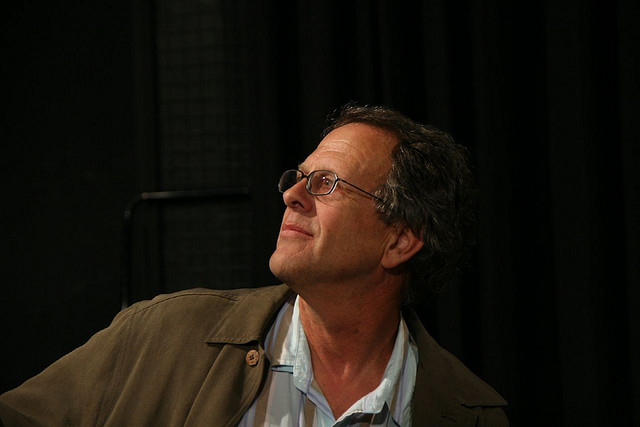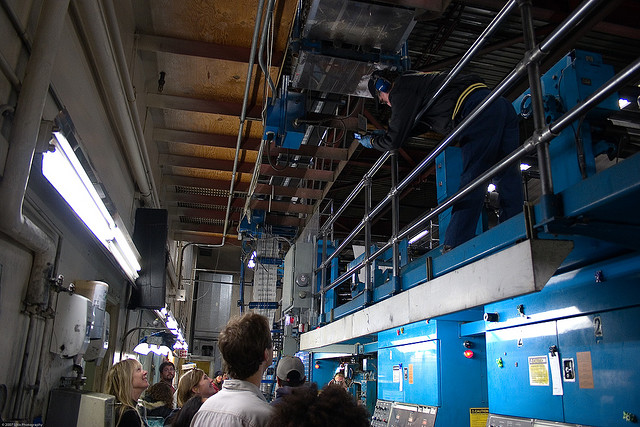It was 8:45 a.m. on a warm August morning in 2006 when Molly Evans, the new publisher of the Santa Cruz Sentinel, stopped by my office and invited me to coffee with the ominous words: “We need to talk.”
We walked to Lulu Carpenter’s downtown coffee house and over a cup of Kona, she broke the news. “We’re for sale,” she said.
Our owner, Ottaway Newspapers, was cutting its smallest-margin holdings, which included the Sentinel. I tried imagining just about every bad thing that could happen to a small community newspaper upon its being sold — and in the months to come, it turned out I wasn’t far off the mark. The Sentinel, like so many Northern California newspapers, ended up a part of MediaNews Group, a private media company controlled by Dean Singleton — a “hatchet man” whose business strategy was to buy up neighboring newspapers, cut staff and combine operations wherever possible.
Singleton came to Santa Cruz that fall under a shroud of secrecy. His aim: to review the paper’s finances while he considered a purchase. As Evans and I took him on a tour of the area, I was made to swear not to tell anyone that Singleton had entered the Sentinel building to view the four-unit press in the basement. Singleton asked a few questions; he acknowledged that he knew little about Santa Cruz County. He also promised, “We give our editors complete autonomy.”
By February of 2007, the deal was done: the Sentinel became one of the final pieces in MediaNews’ “cluster” of Bay Area newspapers, running from Vacaville through Contra Costa County and San Jose and on down to Monterey. Drastic changes then started to happen.
At a meeting of union press workers, MediaNews officials announced that the Sentinel press would shut down. From then on, they said, the paper would be printed in San Jose and trucked over Highway 17 every day.
A short time later, we were told the building would be sold, and, in a final indignity, our office would be moved out of Santa Cruz to an industrial park in nearby Scotts Valley. The Santa Cruz Sentinel wouldn’t even be in Santa Cruz anymore. Six newsroom layoffs were ordered, and by that time I’d seen enough. I was in my 35th year at the paper — the last 12 of which I had served as the editor – and when even more cutbacks were ordered, I got out of the game. I laid myself off.
Unexpected, and hopeful, results
Over a year later I wrote an article, published in the Metro Santa Cruz news weekly, alleging that the important, in-depth news stories we had once championed at the Sentinel were a thing of the past. But today, in 2011, I’m happily surprised to be questioning that conclusion. The evidence, in fact, shows that hard news has not suffered substantial cuts in Santa Cruz; what has diminished, instead, are light features and fluff, while civic news reporting continues to be desired by the public and therefore remains a strong concentration, despite there being fewer reporters on staff to do it.
Now it’s true the Sentinel has a much smaller staff today — 30 full-timers compared to a high of 43 in the old days. However, a comparison of editions from 2010 with those from 10 years earlier shows some surprising results:
- The number of local stories has increased from an average of 25 per edition in 2000, to 33 in 2010.
- Wire stories have dropped from an average of about 48 stories per day down to about 33.
- The number of “light features” has decreased sharply, with only about eight out of 25 local articles in the Sunday editions in 2010 landing up in the “lighter” sections.
One could argue that the Sentinel’s shift to hard news has happened in spite of the paper’s ownership — not because of it. Editor Don Miller and his team have adopted some strategies to keep old-fashioned reporting alive. Some examples:
- The Sentinel has gone outside its own staff to get reporting help on larger stories. For example, in 2009, “Crisis in Care,” a three-day story package about local problems with healthcare, combined efforts of Sentinel staff and the Center for California Health Care Journalism at the University of Southern California.
- The use of correspondents – i.e., freelance reporters paid per story — has increased in the Sentinel’s news section. In 2000, most correspondents were assigned to the features and sports sections; today many more have been moved “news-side.”
- Full-time reporters are still occasionally given time away from their normal news beats to devote to special “project” reporting. In 2010, three such projects were completed.
Still, challenges to the new, reduced staff remain. With the newspaper printed in San Jose, deadlines have been moved earlier — from midnight to 10:30 p.m. on most nights. (The biggest impact of that change has been election night, where final results no longer make it into the following day’s print edition.)
While most Sentinel staffers wouldn’t talk on record, in private conversations many of them acknowledged that they’re working harder than ever before — with fewer resources and no additional salary.
Former Sentinel staff writer Kurtis Alexander, who stayed on for some time after the sale, now works as a reporter at the Fresno Bee. He sees the MediaNews story as a microcosm for the changes sweeping the industry.
“Whether it was MediaNews or the economy, reporters and editors have been forced to do more with less,” he said. “Beats have been merged, meaning coverage runs thinner. There’s greater demand for copy, meaning less time to spend on stories and therefore preference for spot news over enterprise. But even with the challenges, reporters being reporters, and dedicated to their jobs as watchdogs, managed to find time to do the big pieces — even if it wasn’t as often.”
Santa Cruz Mayor Ryan Coonerty agrees. “I think all media outlets are having a difficult time doing larger context pieces. You still get coverage of Congress and bigger states and cities, but not as much of small towns. Most issues are incredibly complex and require an understanding — a nuance,” he said, but “the current news cycle doesn’t leave much room for this, and issues get simplified or ignored.”
He added, “I think it’s a challenge for the media to give reporters two weeks to research an issue.”
A mogul’s failed strategy
In 2006, when he purchased the Sentinel, Singleton had been on an aggressive buying binge across Northern California, where he’d snatched up both the San Jose Mercury News and the Contra Costa Times at a cost of about $750 million. His success hinged on a gamble: if he was able to control costs by “clustering,” or combining journalistic resources from adjoining communities, he could earn a fine return on his investment.
In the end, though, things didn’t work out the way that Singleton planned due to the rapturous changes in the business: a sharp falloff in print readership and advertising, an elusive online audience unwilling to pay for content and, perhaps most devastating as all, a Great Recession that turned all debt into bad debt. When all was said and done, MediaNews Group lay in tatters with nearly $1 billion in debt, and cratering revenues that couldn’t possibly cover the costs of Singleton’s holdings.
In early 2010, Singleton worked out a deal with his lenders to cut the debt to $179 million in return for MediaNews equity, while Singleton and his right-hand man, MNG President Jody Lodovic, were allowed to remain in charge.
But in January of this year, a hedge fund called Alden Globe Capital became the largest shareholder in MediaNews; Lodovic was out, and Singleton was replaced as CEO, given the title instead of “chairman.”
If the impact on Singleton was severe, so has it been on the lives of Bay Area journalists – including myself.
After leaving the Sentinel, I went to work at a Monterey public relations firm. I learned a lot, but some journalists just aren’t made for the PR game. I spent two years there, devoted many months to caring for my elderly parents in their final years, and today I remain in Santa Cruz.
Like many others, I’ve started a hyper-local online newsletter, The Santa Cruz Observer, which is a volunteer effort that pays me nothing. As the NOVA study (see story, B1), with the help of the San Francisco Public Press, revealed, there are a lot of folks out there like myself. It isn’t easy, this journalistic transition, and I have to give credit to those who continue to work in the new newspaper world.
As for the old one, if the Santa Cruz Sentinel remains a good local newspaper — and I think it is one — then it is because of the staff, and in spite of the ownership. It’s something that should give heart to the underlying reasons of why we pursued this work in the first place.

Forty-six individuals donated a total of more than $1,000 to help make possible a special report on changes in media in the Bay Area via the journalism micro-funding website Spot.Us
This article appeared in the spring print edition as part of the Public Press’ media package of stories.










